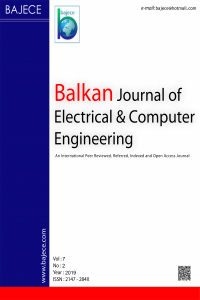Abstract
References
- [1] A. Gupta, R. K. Jha, “A Survey of 5G Network: Architecture and Emerging Technologies”, IEEE Access, vol. 3, 2015, pp.1206-1232.
- [2] 3rd Generation Partnership Project; Technical Specification Group Radio Access Network; Evolved Universal Terrestrial Radio Access (E-UTRA); Physical Channels and Modulation (Release 10), 2011.
- [3] H. J. Zepernick, A. Finger, Pseudo Random Signal Processing: Theory and Application, John Wiley & Sons, 2013.
- [4] V. Krishnaveni, T. Kesavamurthy, B. Aparna, “Beamforming for Direction-of-Arrival (DOA) Estimation-A Survey”, International Journal of Computer Applications, vol. 61, 11, 2013, pp.4-11.
- [5] Y. Khmou, S. Safi, M. Frikel, “Comparative Study between Several Direction Of Arrival Estimation Methods”, Journal of Telecommunications and Information Technology, vol. 1, 2014, pp.41- 48.
- [6] R. J. Weber, Y. Huang, “Analysis for Capon and MUSIC DOA estimation algorithms”, IEEE Antennas and Propagation Society International Symposium, June 2009.
- [7] J. S. Jeong, K. Sakaguchi, J. I. Takada, K. Araki, “Performance of MUSIC and ESPRIT for joint estimation of DOA and angular spread in slow fading environment”, IEICE Transactions on Communications, vol. E85–B, 5, 2002.
- [8] A. Abdelkader, S. Shahbazpanahi, S. Gershman, “Joint subcarrier power loading and distributed beamforming in OFDM-based asynchronous relay networks”, 3rd IEEE International Workshop on Computational Advances in Multi-Sensor Adaptive Processing (CAMSAP), 2009.
- [9] S. Sesia, I. Toufik, M. Baker, LTE – The UMTS Long Term Evolution From Theory to Practice, John Wiley & Sons, 2013.
- [10] C. ZióBkowski, J. M. Kelner,Gershman, “Estimation of the Reception Angle Distribution Based on the Power Delay Spectrum or Profile”, Hindawi Publishing Corporation International Journal of Antennas and Propagation, vol. 2015.
Direction of Arrival Estimation in Multiple Antenna Arrays by Using Power Delay Profile for Random Access Performance in 5G Networks
Abstract
In the transition from 4G to 5G, various solutions are being
developed to improve performance for features such as data rates, latency,
connectivity density and reliability. One of these features is Random Access
Procedure because of the increasing number of users in 5G networks. In the
random access method, user equipment performs a random access to the base
station with a preamble and thus register itself to the base station. However,
if more than one user equipments use the same preamble at the same time,
collision occurs and the registration process in the base station could be
halted. In this paper, a new method is proposed which can be used to calculate
Direction of Arrival between adjacent antenna signals in the antenna array with
the help of the phase differences. Thus, the collision can be avoided by using
the beamforming technique of the MIMO system using the calculated arrival angle
of the user equipment. The proposed method is verified for two user equipments
placed at different angles, at different distances to an antenna array
consisting of 10 antennas.
References
- [1] A. Gupta, R. K. Jha, “A Survey of 5G Network: Architecture and Emerging Technologies”, IEEE Access, vol. 3, 2015, pp.1206-1232.
- [2] 3rd Generation Partnership Project; Technical Specification Group Radio Access Network; Evolved Universal Terrestrial Radio Access (E-UTRA); Physical Channels and Modulation (Release 10), 2011.
- [3] H. J. Zepernick, A. Finger, Pseudo Random Signal Processing: Theory and Application, John Wiley & Sons, 2013.
- [4] V. Krishnaveni, T. Kesavamurthy, B. Aparna, “Beamforming for Direction-of-Arrival (DOA) Estimation-A Survey”, International Journal of Computer Applications, vol. 61, 11, 2013, pp.4-11.
- [5] Y. Khmou, S. Safi, M. Frikel, “Comparative Study between Several Direction Of Arrival Estimation Methods”, Journal of Telecommunications and Information Technology, vol. 1, 2014, pp.41- 48.
- [6] R. J. Weber, Y. Huang, “Analysis for Capon and MUSIC DOA estimation algorithms”, IEEE Antennas and Propagation Society International Symposium, June 2009.
- [7] J. S. Jeong, K. Sakaguchi, J. I. Takada, K. Araki, “Performance of MUSIC and ESPRIT for joint estimation of DOA and angular spread in slow fading environment”, IEICE Transactions on Communications, vol. E85–B, 5, 2002.
- [8] A. Abdelkader, S. Shahbazpanahi, S. Gershman, “Joint subcarrier power loading and distributed beamforming in OFDM-based asynchronous relay networks”, 3rd IEEE International Workshop on Computational Advances in Multi-Sensor Adaptive Processing (CAMSAP), 2009.
- [9] S. Sesia, I. Toufik, M. Baker, LTE – The UMTS Long Term Evolution From Theory to Practice, John Wiley & Sons, 2013.
- [10] C. ZióBkowski, J. M. Kelner,Gershman, “Estimation of the Reception Angle Distribution Based on the Power Delay Spectrum or Profile”, Hindawi Publishing Corporation International Journal of Antennas and Propagation, vol. 2015.
Details
| Primary Language | English |
|---|---|
| Subjects | Electrical Engineering |
| Journal Section | Araştırma Articlessi |
| Authors | |
| Publication Date | April 30, 2019 |
| Published in Issue | Year 2019 Volume: 7 Issue: 2 |
Cited By
All articles published by BAJECE are licensed under the Creative Commons Attribution 4.0 International License. This permits anyone to copy, redistribute, remix, transmit and adapt the work provided the original work and source is appropriately cited.


